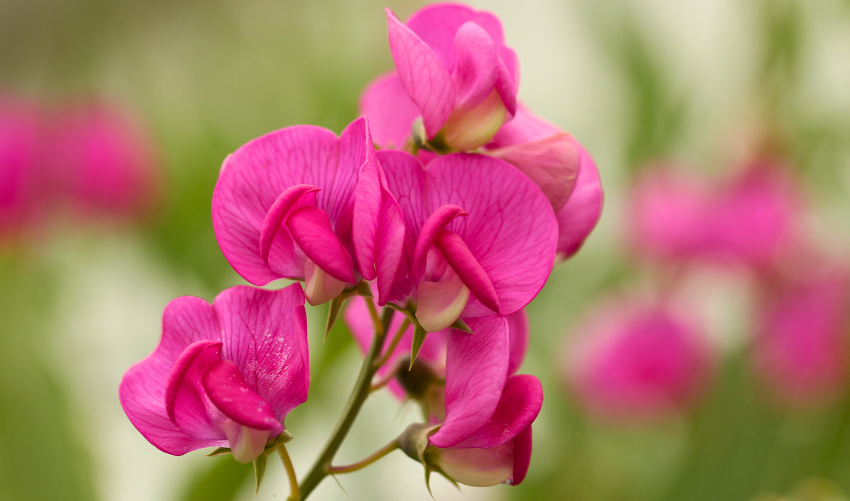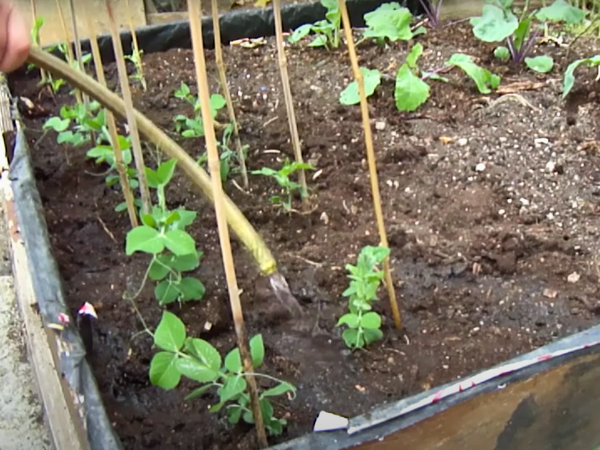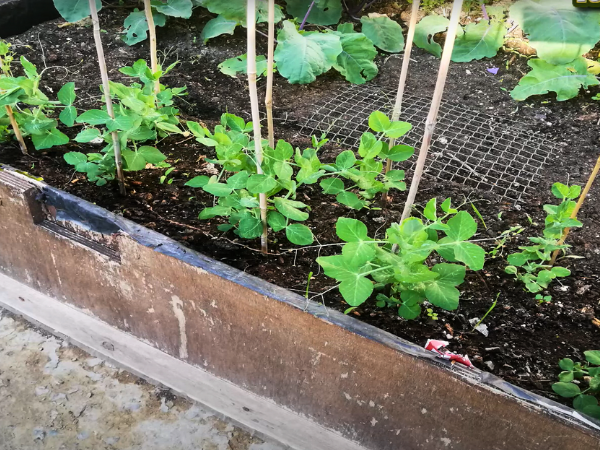In this guide, we will explore the different types of pea flowers you can find. We will also discuss how to grow them successfully in your garden.
You will discover the various uses of these flowers, from culinary delights to medicinal purposes. Finally, we will look at the meaning behind these lovely blooms.
What Are Pea Flowers?
The pea plant, known scientifically as Pisum sativum, is a climbing plant. It grows best in cool climates. The plant produces fruits called pods, which contain the peas. The blooms of pea plants are not only beautiful but essential for reproduction.
Pea flowers are the reproductive part of pea plants. They come in varied forms, primarily featuring two key colors: soft purple and white. These flowers are often found in clusters. Their structure is unique, making them interesting to study.
Distinctive Features Of Pea Blossoms
The flowers are bilaterally symmetrical, resembling butterflies. This unique shape helps attract pollinators. Their soft purple or white colors add to their appeal.
Pea flowers typically grow in pairs or small clusters. This growth pattern enhances their visual impact. The flowers also have a sweet fragrance that attracts insects.
Distinctive Structure: Pea flowers have a recognizable, asymmetrical design made up of five petals:
- The top petal, known as the banner or standard, is usually the largest.
- On each side are two lateral petals called the wings.
- At the bottom, two petals are joined to form a keel—a boat-like enclosure that protects the flower’s reproductive organs.
Understanding these features helps gardeners choose the right varieties. Pea flowers not only beautify gardens but also contribute to the ecosystem.

Common Types Of Pea Flowers
These flowers come in various types, each offering unique characteristics. From edible varieties that enhance meals to ornamental types that beautify gardens, pea flowers are versatile and appealing.
Edible Varieties (Sweet Peas, Snap Peas, Snow Peas)
Edible pea flowers include several popular varieties. These are commonly grown in home gardens and valued for both pods and blooms. Here are three of the most well-known edible types:
- Sweet Peas (Lathyrus odoratus): These are prized for fragrance and garden color. The flowers are beautiful, with a sweet scent. However, the pods are not edible.
- Snap Peas: These peas are sweet and crunchy. The entire pod is edible, making them a popular snack. They are great in salads or stir-fries.
- Snow Peas: Snow peas are flat and tender. The pods can be eaten whole. They add a sweet flavor to dishes.
These edible varieties are not only nutritious but also add beauty to any garden. They attract pollinators and can enhance the flavor of many dishes.

Ornamental Varieties
Ornamental pea flowers bring vibrant colors and unique shapes to gardens. They serve as stunning decorations in many landscapes. Here are some popular ornamental types:
- Garden Peas (Pisum sativum): These are often grown for their lovely flowers and edible pods. The blooms are white or purple and can create a lovely backdrop in gardens.
- Everlasting Peas (Lathyrus latifolius): These perennial flowers bloom throughout summer. They come in shades of pink, purple, and white. Their climbing nature makes them ideal for trellises.
- Perennial Sweet Peas: Similar to annual sweet peas, these flowers are hardy and return each year. They produce fragrant blooms that attract butterflies.
Ornamental pea flowers are easy to grow. They thrive in sunny spots and well-drained soil. Their vibrant colors enhance any garden or landscape.

Symbolism And Meaning Of Pea Flowers
Pea flowers are not just beautiful plants. They carry deep meanings and symbolism. Their delicate nature makes them special in various cultures.
Cultural And Historical Significance
Pea flowers have a rich history in many cultures. They symbolize different emotions and ideas. Here are some key points about their cultural significance:
- Goodbyes: Often associated with goodbyes, pea flowers express emotions linked to farewells.
- Joy and Pleasure: They represent blissful pleasure. Their beauty brings joy to many.
- Victorian Era: In the 19th century, pea flowers had a special place in Victorian floriography.
During this time, flowers were used to convey messages. Pea flowers can convey delicate messages in Victorian floriography. They often represented feelings of admiration and kindness.
Use In Bouquets And Floral Language
Pea flowers are popular in bouquets. They fit well in various floral arrangements, from weddings to casual gatherings.
They can express a range of emotions. Here are some uses of pea flowers in bouquets:
- Weddings: Used to symbolize love and new beginnings.
- Funerals: Often associated with goodbyes and remembrance.
- Friendship: Given to friends to show appreciation and care.
Pea flowers convey delicate messages. Their presence can make a simple bouquet more meaningful. Using pea flowers can enhance the emotional impact of the arrangement.
When And How Pea Flowers Bloom
These flowers not only add charm to gardens but also serve many purposes. Understanding when and how pea flowers bloom helps gardeners maximize their growth and enjoyment.
Seasonal Blooming Timeframes
Most pea flowers bloom in late spring to early summer, depending on the climate. The exact timing can vary based on location and weather conditions. Here are some key points to consider:
- In warmer climates, flowering may begin as early as April.
- In cooler regions, blooms often appear in May or June.
The blooming period typically lasts for several weeks. Below is a table showing the general blooming timeframes for different climates:
| Climate Zone | Blooming Start | Blooming End |
|---|---|---|
| Cool Temperate | May | July |
| Warm Temperate | April | June |
| Tropical | Year-round | N/A |
Pea flowers thrive best in full sun. They prefer well-drained soil. Regular watering encourages healthy blooms.

Encouraging Longer Blooming Periods
Deadheading and cool temperatures help prolong flowering. Deadheading means removing spent blooms. This encourages the plant to produce more flowers.
- Remove faded flowers regularly.
- Provide adequate water without overwatering.
- Use balanced fertilizer during the growing season.
Planting companion flowers can also enhance blooming. Some flowers attract pollinators. More pollinators can lead to increased fruit and flower production. Here are some tips to encourage longer blooms:
- Choose a variety of pea flowers that bloom at different times.
- Provide shade during the hottest part of the day.
- Mulch around plants to retain moisture.
Understanding these practices helps create a vibrant garden filled with beautiful pea flowers.
How To Grow Pea Flowers Successfully
Knowing how to grow pea flowers successfully helps you enjoy their charm and benefits. Follow these guidelines to cultivate stunning pea flowers in your garden.
Ideal Soil, Sun, And Water Conditions
To grow pea flowers successfully, start with the right soil, sun, and water conditions. Pea flowers prefer well-draining soil. This type of soil prevents water from pooling around the roots, which can cause rot.
- Soil pH should be between 6.0 and 7.0.
- Add compost to enrich the soil.
- Ensure good drainage by mixing sand or perlite.
Sunlight is crucial. Pea flowers thrive in full sun. Aim for at least 6 hours of direct sunlight daily. This encourages healthy growth and vibrant blooms.
Watering also plays a vital role. Consistent moisture ensures the best bloom. Follow these watering tips:
- Water deeply but infrequently.
- Check soil moisture before watering.
- Avoid wetting the foliage to prevent disease.
By providing the right balance of deep watering, attentive moisture checks, and careful foliage care, you’ll encourage your pea flowers to flourish.
Supporting Vines And Managing Growth
Pea flowers often grow as climbing vines. Supporting these vines is essential for their health. Use trellises or netting to help climbing varieties thrive.
Manage growth by following these practices:
- Pinch back young plants to encourage branching.
- Regularly check for pests like aphids.
- Remove dead or yellowing leaves to promote new growth.
Prune as needed to control size and shape. Regular pruning helps maintain a tidy appearance. Keep an eye on the vines as they grow. They may need additional support as they become heavier with flowers.
With proper support and management, your pea flowers will flourish, providing beauty and charm to your garden.
Uses Of Pea Flowers
These flowers have many uses in cooking, gardening, and even in nature. From culinary delights to garden aesthetics, pea flowers offer something special.
Culinary And Edible Uses
Edible pea flowers are a delightful addition to many dishes. Their sweet and delicate flavor enhances meals and adds visual appeal. They are often used in salads and as garnishes.
- Used fresh in salads for added color and taste.
- Steamed or sautéed as a side dish.
- Infused in teas for a unique flavor.
- Used in desserts for a pop of color.
The vibrant colors of pea flowers make them a favorite in gourmet cooking. They can be used in various ways:
| Dish Type | Use of Pea Flowers |
|---|---|
| Salads | Fresh garnish for taste and color. |
| Soups | Used as a colorful topping. |
| Drinks | Infused in teas or cocktails. |
| Desserts | Decorative element in cakes and pastries. |
Incorporating edible pea flowers into your meals can enhance both flavor and presentation. Their unique taste can surprise and delight your guests.
Decorative And Pollinator Benefits
Pea flowers not only serve culinary purposes. They also play a crucial role in gardens. They add color to gardens and attract bees and other beneficial insects. Here are some benefits:
- Brighten up garden spaces with vibrant colors.
- Support local ecosystems by attracting pollinators.
- Enhance the beauty of flower arrangements.
- Provide ground cover to prevent weeds.
Planting pea flowers can encourage biodiversity in your garden. They bloom in various shades, including purple, blue, and white.
Here’s a quick look at how pea flowers benefit gardens:
| Benefit | Description |
|---|---|
| Attract Pollinators | Draw in bees and butterflies for pollination. |
| Soil Health | Improve soil quality by fixing nitrogen. |
| Visual Appeal | Enhance garden aesthetics with colorful blooms. |
| Natural Pest Control | Support beneficial insects that control pests. |
Using pea flowers in your garden can create a vibrant, healthy environment. They are not only beautiful but also beneficial to nature.










